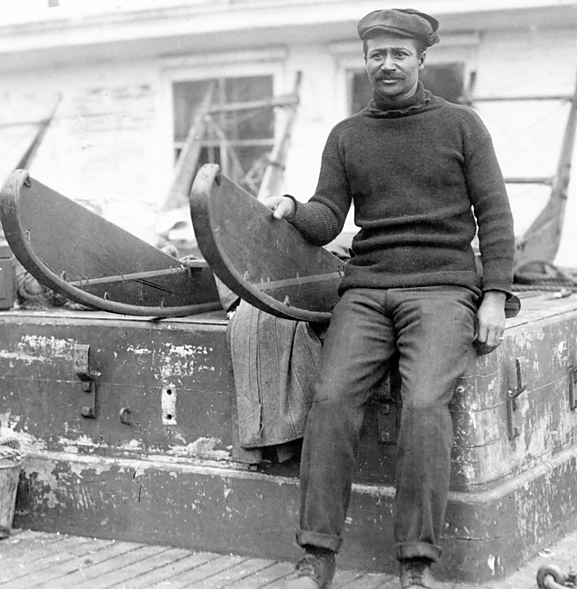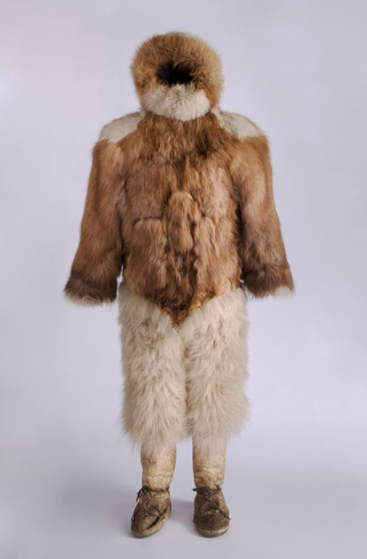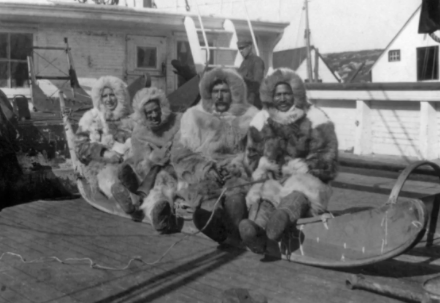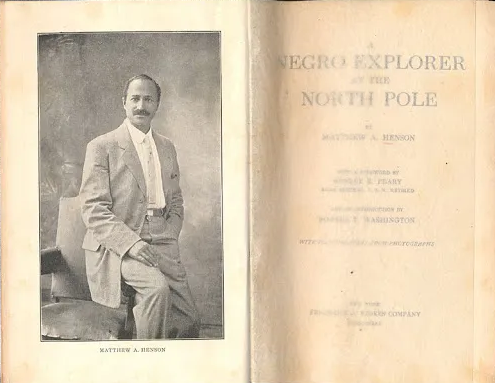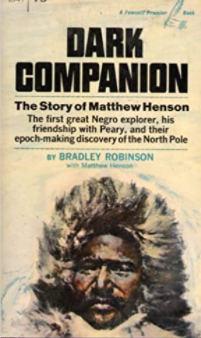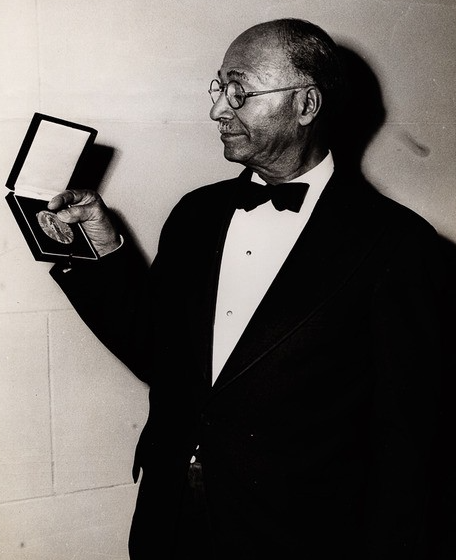A Life of Exploration: Matthew Henson’s Arctic Journey Into History
Picture of Matthew Henson preparing for the frigid march that would forever alter the face of exploration. (Courtesy of The University of Delaware)
The North Pole has long since been characterized by the holiday images of Santa Claus, his wife, a toy-making factory of elves and Rudolph's glowing nose leading his bearded employer's sleigh into a starry Christmas Eve night. It seems childish to think this could be true, but many adults really have no real, actual concept of the frozen lands of ice and gale force winds at The North Pole that make our heavy blizzards look more like light dustings. Matthew Henson experienced it first hand. The intrepid Arctic explorer who is believed to be the first man to ever reach The North Pole found nothing that reminded him of wrapped boxes of gifts. Just the frigid white of an uncharted terrain many before him died over a 300-year span trying to navigate in order to 'discover'. Any mention of Henson often begins and ends with the ice-covered treading done toward his extraordinary achievement, but that was just the tip of the iceberg when it comes to this explorer, author and scholar who took his first barefoot steps on the grass of farm his family owned for three-generations in Nanjemoy–a town in Charles County, Maryland.
Map of Charles County, Maryland—which sits just over 30 miles south of Washington, D.C.—from 1866, the year Matthew Henson was born. (Courtesy of Berkshire Museum)
Matthew Henson was born to Lumel and Caroline on August 8, 1866. One older sister and two younger ones rounded out the family. His parents were both ‘free people of color’ long before the Civil War started and ended. The family’s societal rank was based on its diverse ancestry of African, European as well as various tribes of indigenous people native to The Americas and throughout The Caribbean. This inalienable freedom to live and work just as white people were oddities during a time when the inhumane practices serving as the foundation for the institution of slavery were in full effect. The Emancipation Proclamation, however, stripped the Hensons of this caste-based privilege as the South grudgingly adjusted to the antebellum era of Reconstruction.
Threatening acts of intimidation from the newly formed Klu Klux Klan forced the Hensons to leave their farm in Charles County for a new one in Georgetown–which at the time was not yet a part of Washington, D.C.--when he was seven. Tragedy untimely struck as first his mother and then father died only a few years later leaving young Matthew to be raised by his uncle who paid for young Henson’s education before passing away himself. Henson’s classroom education on land abruptly stopped in 1878 at the age of twelve when Captain Childs, leader of the international merchant ship Katie Hines, took the youth aboard to run errands as a ‘cabin boy’ and taught him how to read and write as the international voyage departed from the thriving port city of Baltimore before making stops along the coasts of China, Japan, Russia and the continent of Africa. This early introduction to nautical life taught the teenage Henson the finer points of exploration while stepping into varying scenes and locales of the world.
Here is the circumpolar map showing The North Pole drawn by Edward Stanford in 1876 illustrating the Arctic’s sea ice-covered coastline in the light blue portions. (Courtesy of The Library and Archives Canada)
It was 1885 when Henson began his first job on land. After spending years at sea, he found himself working at B.H. Stinemetz and Sons, a premier department store at the time, back in Washington, D.C. as a sales clerk. No longer living life aboard, Henson was adjusting to the normalcy of adulthood without the adventurous spoils his previous career gave him daily. This instantly changed in 1887 when Robert Peary, an explorer and officer in the United States Navy, walked into the department store and asked Henson for his service. During this interaction between salesman and customer, Henson was able to detail his experiences at sea while Peary spoke of the surveying he was about to start for the difficult Nicaraguan Canal project that would connect the Caribbean Sea to the Pacific Ocean. Peary, impressed with Henson’s budding exploring resume, soon invited him into his exploration team as a valet. The massive undertaking of connecting oceans through Nicaragua was never completed. Peary led a dog sledding tour of Greenland the same year before meeting Henson. The trek was unsuccessful, but Peary wanted to return to try again with a ‘first man’ like Henson at his side during a similar expedition. His sights pointed both men to the chilling scapes of The Arctic as he and Peary boarded The Roosevelt, the boat that carried the Peary and Henson-led team.
What started as one trip turned into many over that 20-year-span of time that brought Henson to the land of the Inuits (or Eskimos)–the indigenous people who still currently inhabit Alaska, Canada and Greenland to this day. Here is where Henson learned Mahri-Pahluk, the language of the Inuits, and began ingratiating himself with the customs of the land such as training dogs for long treks over snow becoming the first non-Inuit to learn the trade. So much so he wound up fathering his only child–an Inuit son named Anauakaq–leading up to the journey that would cement his place in history.
Robert Peary’s photograph of Matthew Henson and four Inuit men standing at The North Pole. (Courtesy of Wikipedia)
The Arctic tours prepared Henson and Peary for the 1908-1909 expedition to The North Pole. According to a 2003 article in National Geographic titled ‘African-American North Pole Explorer Matthew Henson’, the group included ‘Inuit men and 130 dogs working to lay a trail and supplies along the route to the Pole’ when they arrived in February 1909 at Canada’s Cape Sheridan neighboring Greenland on the edge of the Arctic Ocean. Peary had been a part of 28 trails to reach The North Pole, but failed before teaming up with Henson. Battling frostbiting winds over a desolate, white landscape with temperatures that dipped to near −70° Fahrenheit, Henson braved the conditions using all the skills learned from the Inuit. Peary was exhausted midway through the journey and was growing ill due to the unforgiving elements. Henson was tabbed by Peary to continue leading the expedition as he followed behind in a dogsled. The act of leading people to a place yet seen is a task all by itself. From a quote often attributed to Matthew Henson, we can imagine what was possibly going through his head during each grueling step onward into the icy abyss.
“The path is not easy, the climbing is rugged and hard, but the glory at the end is worthwhile. It'll work, if God, wind, leads, ice, snow, and all the hells of this damned frozen land are willing.”
Moving towards that which is not immediately before you is the working definition of faith Henson was being guided by as he braced for and squinted into the nothingness ahead. Each step tested the mettle of Henson’s resilience and started his ascent to the unparalleled ‘glory’ he was miles away from embracing. With only a handful of the traveling Inuit men still at his side Ootaq, Egingwah, Sipsu and Ooqueeah, Henson reached the North Pole becoming the first man to do so before planting the pole of the American Flag feet deep into the tall mound of ice-covered snow.
Henson published his memoir, A Negro Explorer at the North Pole, in 1912 only three years removed from his unbelievable triumph and spoke at many honorary dinners throughout the black community, but still failed to get the recognition he truly deserved initially. Fame stemming from this unprecedented achievement did not come instantly for Henson in the following years as Peary received the lion’s share of the credit while he was relegated to only having a bit part in this arduous story of man versus nature–man versus self. Henson was able to secure employment for the U.S. House of Customs where he worked for 30 years after President Theodore Roosevelt appointed him to the position and became a member of the esteemed Explorers Club in 1937 before being awarded The Peary Polar Expedition Medal in 1944 by Congress. Henson was published again in 1947 when he released his biography and most celebrated account of the 1908-1909 Polar Expedition–Dark Companion. Both Presidents Truman and Eisenhower gave Henson his final set of praises right before his death on March 9, 1955.
Much speculation surrounded, and still does, Henson’s feat as historians have openly discredited citing that Dr. Frederick Cook did so months before Peary and Henson informed The New York Times from an outpost at Indian Harbour, Labrador that they did so in April of 1909. Whether or not Henson was ‘the first’ to The North Pole is less significant when you see where his journey started. His life speaks to the traveler in all of us and sets the bar high for the coming generations of black travel in general. Matthew Henson’s drive to explore is what fuels the inquisitive black minds of today who are seeking new lands to walk, new people to meet and all the other benefits that come with firmly stepping out of their comfort zone and into the vast and beautiful world awaiting them.




